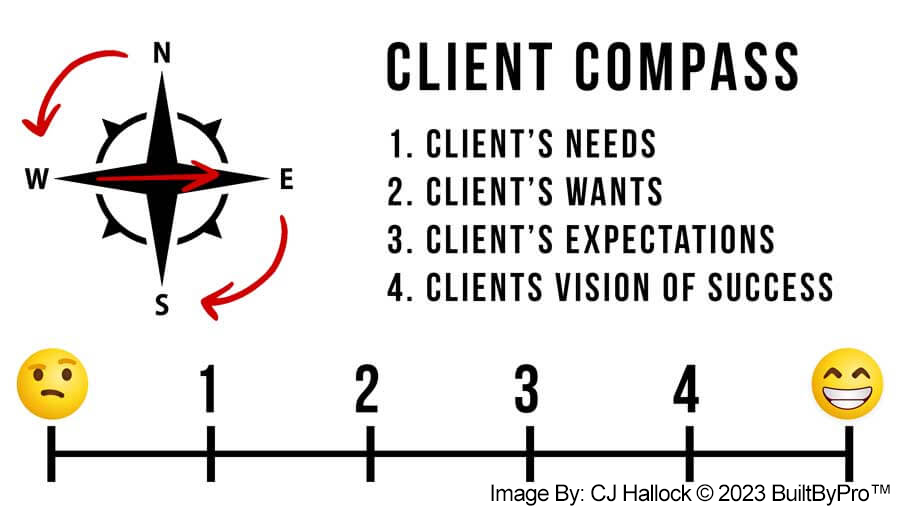The client compass is the breakdown of the journey that your clients/customers will make in order to get from where they are to where they want to be. This is going from a person who thinks “I want [your products/services]” through hiring you/buying your products.
This is important because when you know what your target market is thinking and can prove you are there to help them by actually helping them, you build on a relationship before it exists.
So the purpose of the client compass is to know what would actually help. Understanding every step it takes to move your potential clients to be your actual client and beyond.
The magic with this exercise is in not just going through the initial steps. When you understand every step of their journey and can help them even after they hire you or buy your products, you create brand ambassadors which are the key to growing your business into a brand that is known as the best.
The Client Compass Overview

The visual of a compass will break down what you should focus on within the client compass when addressing your target market.
If you replace each of the directions with the different things you should address while delivering content it will be four main pillars.
- (N)orth becomes your CLIENT’S NEEDS
- (W)est becomes your CLIENT’S WANTS
- (E)ast becomes your CLIENT’S EXPECTATIONS
- (S)outh becomes your CLIENT’S VISION OF SUCCESS
If you use your content to address your client’s Needs, Wants, Expectations, and vision of Success, the process of working with you will be a breeze.
But, let’s be honest, it’s hard to understand what someone is going through, and how to help them, without understanding who they are. That leads us to our next important step.
Understanding Your Target Market
So the first thing we need to focus on is your Target Market.
That is because, at the core, your target market wants one thing.
So what does your target market want?
Before we can answer that, we need to first look into what a target market is.
What Is A Target Market?
A Target Market is a particular group of consumers at which a product or service is aimed.
There are 3 main things that define your target market
That’s Demographics, Psychographics, and Geographics. The last one is an actual thing … if it’s not then it is now!
Jumping into the Demographics of your target market – this is their age, race, gender, education level, employment, income, etc.
The next thing is Psychographics, which is their personality, their beliefs, values, lifestyle, etc.
The final part to your target market is Geographics which is where they work, where they live, where do they network in person and/or online.
“Everyone” is not your target market but you know that already.
So let’s start with the questions and start to narrow down our target market.
17 Questions To Help You Define Your Target Market
How old is your client?
Are they married?
What interests do they have?
What neighborhood do they want to move into?
What kind of job do they have?
How much money do they make?
Do they have kids?
If so, how many & how old are they?
Are they religious?
What kind of music do they like?
What other brands do they follow?
What hours are they online?
What do they wear?
What are their hobbies?
Do they work out?
Do they follow sports?
If so, what’s their favorite team & favorite player?
While this may seem like a stretch but some of this can help you move from a potential client to your business having a Brand Ambassador, basically someone who won’t stop talking about the importance of using YOUR PRODUCTS/SERVICES.
It also helps you relate to your target market in the content you put out.
Why Naming Your Target Market Is Important
Now is the time to name your target market. But you’re not naming a group, you’re taking the answers and creating a person. Yes, like a said before, you are creating an imaginary friend. & while I say that tongue in cheek I’m kind of serious. Once you create this person, the content you put out is directed to him or her.
I first went through this concept of “Naming Your Target Market” with an old training from the marketing mastermind, Frank Kern. He’s an amazing marketer and released this training called “Core Influence” I believe originally it was a bonus for his $3000 marketing course Mass Control. & honestly, it was my favorite part of the entire training.
He named his person “Bob”
He described him like this…
Bob is an accountant, who is 38 years old. He is married with two kids in high school that drive him crazy. He makes $50-60,000 per year and wears polo shirts with khakis & penny loafers.
He had told the story of creating “Bob” at a few different marketing conferences. Then at one of the conferences, Bob introduced himself to Frank after he got off stage.
Frank says he walked up with a smile on his face, wearing a polo shirt, khakis, and penny loafers. He said, “Hi I’m Bob and you nailed me on the head. I’m an accountant. I turn 38 next week. I’m married and have two kids in high school. The only thing you got wrong is my kids don’t drive me crazy.”
While he went semi-specific, the deeper into the details you can go with this and it actually fits more than a handful of people, the better.
When you get to the point of putting out content and trying to help your target market, it’s easier to understand the best way to help them when you literally say to yourself …
“Bob, I understand your problem, and here’s a solution.” Obviously, addressing your own target market.
You know what they want & what their problems are. And now that you know who they are you can start blending that content together.



